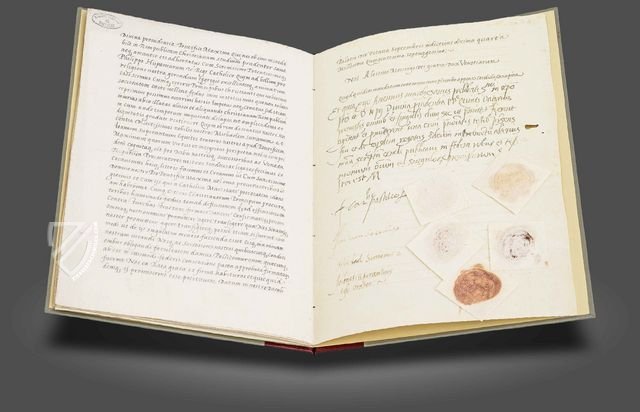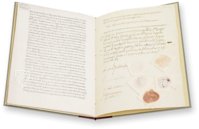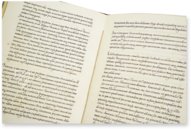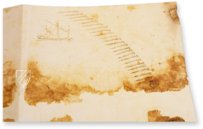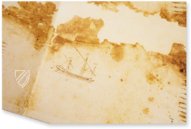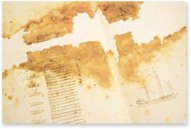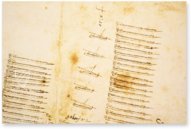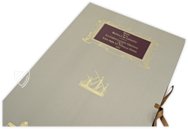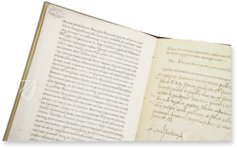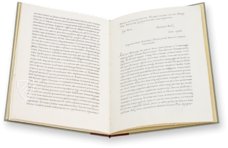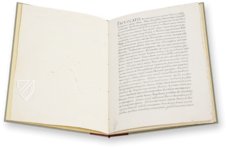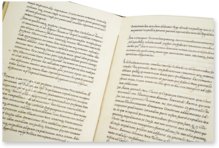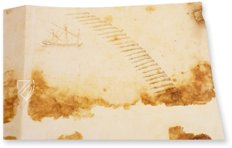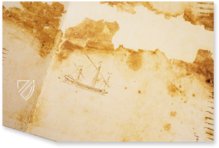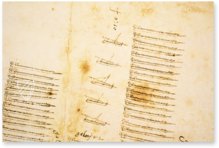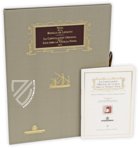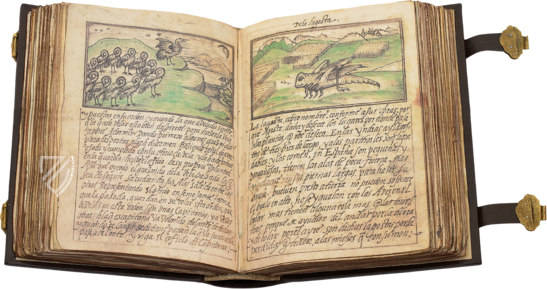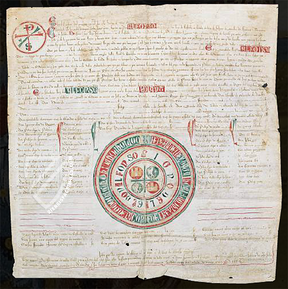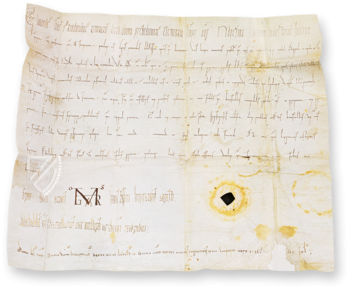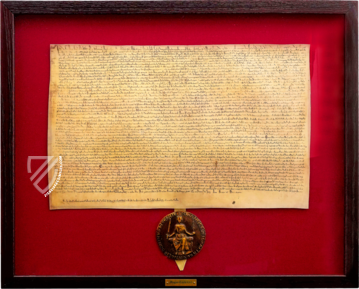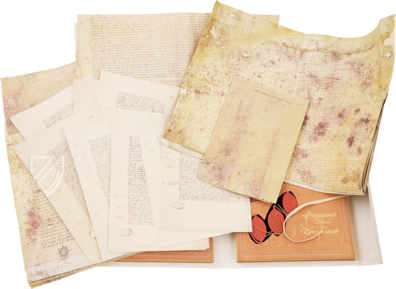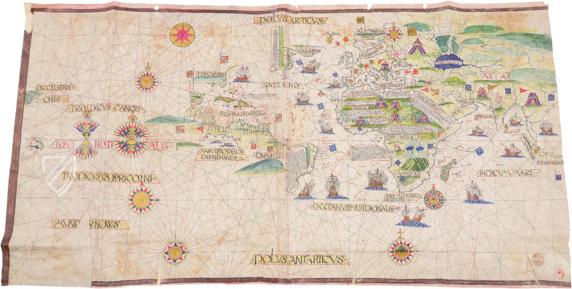Battle of Lepanto: Essential Documents
(under 1,000€)
The Spanish General Archive in Simanacas houses unique documents relating to one of the most important events of 16th century Christendom: the naval Battle of Lepanto in 1571. In this noteworthy battle off the coast of Greece, the Holy League triumphed over the mighty fleet of the Turks and in doing so, secured the supremacy of Spain at the expense of Ottoman power in the Mediterranean. A unique compendium of four documents bears witness to this historic event: the original document of the Holy League signed on the 25th of May, 1571 by the three participating parties, an original map of the battles with the formation of the opposing fleets, an anonymous yet detailed account of the events of the battle, and additionally, a letter dated the 10th of October, 1571 from Juan de Austria to his half-brother Philipp II, in which he informs the king of the Christian’s victory. Unique historical documents of exceptional worth!
Battle of Lepanto: Essential Documents
The Spanish General Archive in Simanacas houses unique documents relating to one of the most important events of 16th century Christendom: the naval Battle of Lepanto in 1571. In this noteworthy battle off the coast of Greece, the Holy League triumphed over the mighty fleet of the Turks and in doing so, secured the supremacy of Spain at the expense of Ottoman power in the Mediterranean. A unique compendium of four documents bears witness to this historic event: the original document of the Holy League signed on the 25th of May, 1571 by the three participating parties, an original map of the battles with the formation of the opposing fleets, an anonymous yet detailed account of the events of the battle, and additionally, a letter dated the 10th of October, 1571 from Juan de Austria to his half-brother Philipp II, in which he informs the king of the Christian’s victory. Unique historical documents of exceptional worth!
The Noteworthy Naval Battle
On the 7th of October, 1571 in the Gulf of Lepanto off the west coast of Greece, the fleet of the Holy League met with the Turks under the command of Sultan Selim II. The Christians embarked from the Sicilian city of Messina and boasted a modern fleet. Their commander was Don Juan de Austria, illegitimate son of Emperor Charles V and therefore the half-brother of the Spanish King Philipp II, and already a tried and tested warrior and commander of the Spanish Mediterranean fleet at the age of 24. In a gigantic battle – involving 700 ships and 80,000 combatants on the side of the Christians – the Holy League won a triumphant victory over the Ottoman fleet, thereby securing the Mediterranean from the Turkish threat.
The Holy League
The power of the Turks in the western Mediterranean was a constant menace in the 16th century for the Spanish and Italian coasts, which mostly belonged to Spain. Attacks and raids put the people living on the coasts in a state of fear and anxiety, and the sieges of Malta and Cyprus in 1565 and 1570 made the imminent expansion of this Ottoman power an urgent issue. The powerful fleet of the Turks had to be pushed back. For this reason, in May of 1571 the Republic of Venice, Pope Pious V, and Philipp II concluded an alliance against the Ottomans: the so-called Holy League was born.
Documents of World History
The event of the Holy League’s founding is certified with the original document from the 25th of May, 1571. The vellum document is signed by the three participants. With this mighty alliance the groundwork was laid for the triumph at Lepanto. The great hopes of Christianity lay on these important figures. The original map of the sea battle allows the event to be uniquely understood. The map is furnished with notes and records in Italian. It shows the formation of the opposing fleets, the Christians in the form of a cross, the Turks that of a crescent moon.
The Joy over the Triumph
The wonderful result of the battle for the Christians – according to the official data 90 Turkish ships were sunk and 130 were captured, while the Holy League lost only 15 ships – can be understood by means of two additional documents: the account of an unknown author describes, in detail, the events of the battle believably and impartially. And in a Letter from Juan de Austria to Philipp II. from the 10th of October 1571, the commander of the Holy League informs the Spanish Kings of the Christian fleet’s victory. The Spanish National Poet Miguel de Cervantes, who participated himself in the battle, named the Lepanto naval battle a noteworthy event. Up to this day, the Battle of Lepanto is considered to be an important event of Spanish and even world history that can be impressively brought to light by the original documents at hand.
Codicology
- Alternative Titles
- Mapa de la Batalla de Lepanto
Die Schlacht von Lepanto - Origin
- Spain
- Date
- 1571
- Epochs
- Style
- Language
- Patron
- John of Austria
Battle of Lepanto: Essential Documents
Christian Fleet, Center and Reserve Divisions
Juan de Austria, appointed by the Holy League to be commander-in-chief of the fleet facing off with the Turks, personally took command of the Center Division in his flagship, the Real. Two large “galleasses”, heavily armed with artillery, served as the spear heads to 62 galleys supported by a Reserve Division of another 46 galleys. Don Juan met with the flagship of the Ottoman admiral, Ali Pasha, boarding and killing all onboard and hoisting his banner on its mast, breaking Turkish morale.
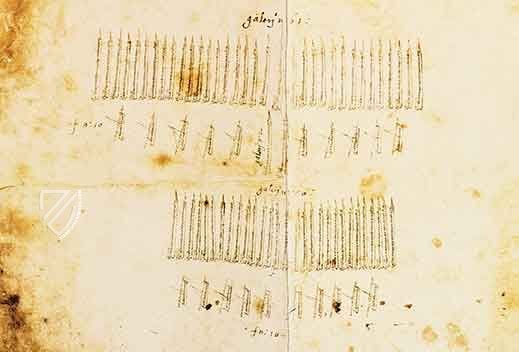
Battle of Lepanto: Essential Documents
Plan of Battle
On October 7th, 1571, the navy of the Ottoman Empire, which had previously dominated the Mediterranean and threatened to carry invading armies to Italy, was decisively defeated at the Battle of Lepanto by a Christian alliance known as the Holy League. Here, the line of battle for the last major naval engagement in the West to be fought entirely by rowing vessels is depicted in detail.
At the top of the page, we see the Ottoman fleet deployed in a long curved line. It is facing off with the combined fleet of the Holy League, which is deployed in three squadrons with a fourth in reserve. Four so-called “galleasses”, large new Venetian warships carrying an abundance of artillery, act as spearheads for the rest of the fleet.
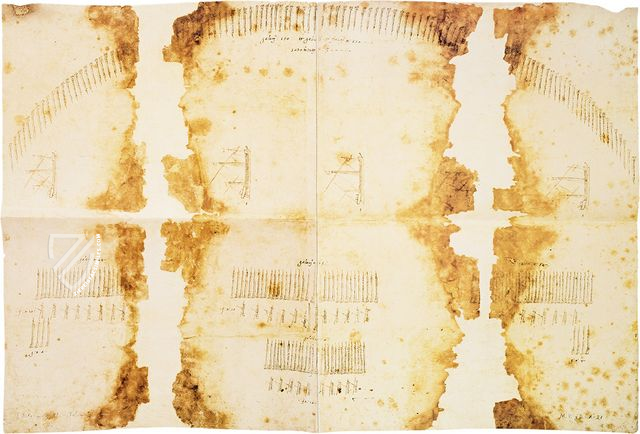
#1 Mapa de la Batalla de Lepanto
Language: Spanish
(under 1,000€)
- Treatises / Secular Books
- Apocalypses / Beatus
- Astronomy / Astrology
- Bestiaries
- Bibles / Gospels
- Chronicles / History / Law
- Geography / Maps
- Saints' Lives
- Islam / Oriental
- Judaism / Hebrew
- Single Leaf Collections
- Leonardo da Vinci
- Literature / Poetry
- Liturgical Manuscripts
- Medicine / Botany / Alchemy
- Music
- Mythology / Prophecies
- Psalters
- Other Religious Books
- Games / Hunting
- Private Devotion Books
- Other Genres
- Afghanistan
- Armenia
- Austria
- Belgium
- Belize
- Bosnia and Herzegovina
- China
- Colombia
- Costa Rica
- Croatia
- Cyprus
- Czech Republic
- Denmark
- Egypt
- El Salvador
- Ethiopia
- France
- Germany
- Greece
- Guatemala
- Honduras
- Hungary
- India
- Iran
- Iraq
- Israel
- Italy
- Japan
- Jordan
- Kazakhstan
- Kyrgyzstan
- Lebanon
- Liechtenstein
- Luxembourg
- Mexico
- Morocco
- Netherlands
- Palestine
- Panama
- Peru
- Poland
- Portugal
- Romania
- Russia
- Serbia
- Spain
- Sri Lanka
- Sweden
- Switzerland
- Syria
- Tajikistan
- Turkey
- Turkmenistan
- Ukraine
- United Kingdom
- United States
- Uzbekistan
- Vatican City
- A. Oosthoek, van Holkema & Warendorf
- Aboca Museum
- Ajuntament de Valencia
- Akademie Verlag
- Akademische Druck- u. Verlagsanstalt (ADEVA)
- Aldo Ausilio Editore - Bottega d’Erasmo
- Alecto Historical Editions
- Alkuin Verlag
- Almqvist & Wiksell
- Amilcare Pizzi
- Andreas & Andreas Verlagsbuchhandlung
- Archa 90
- Archiv Verlag
- Archivi Edizioni
- Arnold Verlag
- ARS
- Ars Magna
- ArtCodex
- AyN Ediciones
- Azimuth Editions
- Badenia Verlag
- Bärenreiter-Verlag
- Belser Verlag
- Belser Verlag / WK Wertkontor
- Benziger Verlag
- Bernardinum Wydawnictwo
- BiblioGemma
- Biblioteca Apostolica Vaticana (Vaticanstadt, Vaticanstadt)
- Bibliotheca Palatina Faksimile Verlag
- Bibliotheca Rara
- Boydell & Brewer
- Bramante Edizioni
- Bredius Genootschap
- Brepols Publishers
- British Library
- C. Weckesser
- Caixa Catalunya
- Canesi
- CAPSA, Ars Scriptoria
- Caratzas Brothers, Publishers
- Carus Verlag
- Casamassima Libri
- Centrum Cartographie Verlag GmbH
- Chavane Verlag
- Christian Brandstätter Verlag
- Circulo Cientifico
- Club Bibliófilo Versol
- Club du Livre
- CM Editores
- Collegium Graphicum
- Collezione Apocrifa Da Vinci
- Comissão Nacional para as Comemorações dos Descobrimentos Portugueses
- Coron Verlag
- Corvina
- CTHS
- D. S. Brewer
- Damon
- De Agostini/UTET
- De Nederlandsche Boekhandel
- De Schutter
- Deuschle & Stemmle
- Deutscher Verlag für Kunstwissenschaft
- DIAMM
- Droz
- E. Schreiber Graphische Kunstanstalten
- Ediciones Boreal
- Ediciones Grial
- Ediclube
- Edições Inapa
- Edilan
- Editalia
- Edition Deuschle
- Edition Georg Popp
- Edition Leipzig
- Edition Libri Illustri
- Editiones Reales Sitios S. L.
- Éditions de l'Oiseau Lyre
- Editions Medicina Rara
- Editorial Casariego
- Editorial Mintzoa
- Editrice Antenore
- Editrice Velar
- Edizioni Edison
- Egeria, S.L.
- Eikon Editores
- Electa
- Emery Walker Limited
- Enciclopèdia Catalana
- Eos-Verlag
- Ephesus Publishing
- Ernst Battenberg
- Eugrammia Press
- Extraordinary Editions
- Fackelverlag
- Facsimila Art & Edition
- Facsimile Editions Ltd.
- Facsimilia Art & Edition Ebert KG
- Faksimile Verlag
- Feuermann Verlag
- Folger Shakespeare Library
- Franco Cosimo Panini Editore
- Friedrich Wittig Verlag
- Fundación Hullera Vasco-Leonesa
- G. Braziller
- Gabriele Mazzotta Editore
- Gebr. Mann Verlag
- Gesellschaft für graphische Industrie
- Getty Research Institute
- Giovanni Domenico de Rossi
- Giunti Editore
- Graffiti
- Grafica European Center of Fine Arts
- Guido Pressler
- Guillermo Blazquez
- Gustav Kiepenheuer
- H. N. Abrams
- Harrassowitz
- Harvard University Press
- Helikon
- Hendrickson Publishers
- Henning Oppermann
- Herder Verlag
- Hes & De Graaf Publishers
- Hoepli
- Holbein-Verlag
- Houghton Library
- Hugo Schmidt Verlag
- Idion Verlag
- Il Bulino, edizioni d'arte
- ILte
- Imago
- Insel Verlag
- Instituto de Estudios Altoaragoneses
- Instituto Nacional de Antropología e Historia
- Istituto dell'Enciclopedia Italiana - Treccani
- Istituto Ellenico di Studi Bizantini e Postbizantini
- Istituto Geografico De Agostini
- Istituto Poligrafico e Zecca dello Stato
- Italarte Art Establishments
- Jan Thorbecke Verlag
- Johnson Reprint Corporation
- Josef Stocker
- Josef Stocker-Schmid
- Jugoslavija
- Karl W. Hiersemann
- Kasper Straube
- Kaydeda Ediciones
- Kindler Verlag / Coron Verlag
- Kodansha International Ltd.
- Konrad Kölbl Verlag
- Kurt Wolff Verlag
- La Liberia dello Stato
- La Linea Editrice
- La Meta Editore
- Lambert Schneider
- Landeskreditbank Baden-Württemberg
- Leo S. Olschki
- Les Incunables
- Liber Artis
- Library of Congress
- Libreria Musicale Italiana
- Lichtdruck
- Lito Immagine Editore
- Lumen Artis
- Lund Humphries
- M. Moleiro Editor
- Maison des Sciences de l'homme et de la société de Poitiers
- Manuscriptum
- Martinus Nijhoff
- Maruzen-Yushodo Co. Ltd.
- MASA
- Massada Publishers
- McGraw-Hill
- Metropolitan Museum of Art
- Militos
- Millennium Liber
- Müller & Schindler
- Nahar - Stavit
- Nahar and Steimatzky
- National Library of Wales
- Neri Pozza
- Nova Charta
- Oceanum Verlag
- Odeon
- Orbis Mediaevalis
- Orbis Pictus
- Österreichische Staatsdruckerei
- Oxford University Press
- Pageant Books
- Parzellers Buchverlag
- Patrimonio Ediciones
- Pattloch Verlag
- PIAF
- Pieper Verlag
- Plon-Nourrit et cie
- Prestel Verlag
- Princeton University Press
- Prisma Verlag
- Priuli & Verlucca, editori
- Pro Sport Verlag
- Propyläen Verlag
- Pytheas Books
- Quaternio Verlag Luzern
- Reales Sitios
- Recht-Verlag
- Reichert Verlag
- Reichsdruckerei
- Reprint Verlag
- Riehn & Reusch
- Roberto Vattori Editore
- Rosenkilde and Bagger
- Roxburghe Club
- Salerno Editrice
- Saltellus Press
- Sandoz
- Sarajevo Svjetlost
- Schöck ArtPrint Kft.
- Schulsinger Brothers
- Scolar Press
- Scrinium
- Scripta Maneant
- Scriptorium
- Shazar
- Siloé, arte y bibliofilia
- SISMEL - Edizioni del Galluzzo
- Sociedad Mexicana de Antropología
- Société des Bibliophiles & Iconophiles de Belgique
- Soncin Publishing
- Sorli Ediciones
- Stainer and Bell
- Studer
- Styria Verlag
- Sumptibus Pragopress
- Szegedi Tudomànyegyetem
- Taberna Libraria
- Tarshish Books
- Taschen
- Tempus Libri
- Testimonio Compañía Editorial
- Thames and Hudson
- The Clear Vue Publishing Partnership Limited
- The Facsimile Codex
- The Folio Society
- The Marquess of Normanby
- The Richard III and Yorkist History Trust
- Tip.Le.Co
- TouchArt
- TREC Publishing House
- TRI Publishing Co.
- Trident Editore
- Typis Regiae Officinae Polygraphicae
- Union Verlag Berlin
- Universidad de Granada
- University of California Press
- University of Chicago Press
- Urs Graf
- Vallecchi
- Van Wijnen
- VCH, Acta Humaniora
- VDI Verlag
- VEB Deutscher Verlag für Musik
- Verlag Anton Pustet / Andreas Verlag
- Verlag Bibliophile Drucke Josef Stocker
- Verlag der Münchner Drucke
- Verlag für Regionalgeschichte
- Verlag Styria
- Vicent Garcia Editores
- W. Turnowski Ltd.
- W. Turnowsky
- Waanders Printers
- Wiener Mechitharisten-Congregation (Wien, Österreich)
- Wissenschaftliche Buchgesellschaft
- Wissenschaftliche Verlagsgesellschaft
- Wydawnictwo Dolnoslaskie
- Xuntanza Editorial
- Zakład Narodowy
- Zollikofer AG

